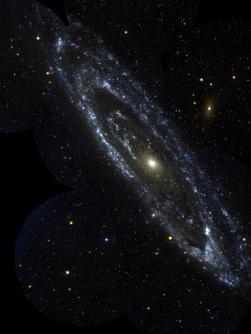Stephen Perrenod's Blog
September 28, 2019
A Billion-Year Triple Merger
[image error]
These three galaxies are expected to merge over the next billion years. The ensemble is known as SDSS J084905.51+111447.2. Credit SDSS & NASA/STScI
This gravitationally bound triplet of active galaxies is at redshift of z = 0.077, corresponding to a distance of around 1 billion light-years.
They have been studies in the near-infrared, optical, and X-ray portions of the spectrum, and each galaxy shows evidence of a supermassive black hole at its respective center. The largest of these central black holes looks to be a billion times the mass of the Sun.
Thee projected separation on the sky is only 30,000 light-years, so they are well along in the process of merging due to tidal interactions. The merger of two, and then one more, supermassive black holes will lead to some amazing fireworks.
Here’s the kicker: we are seeing this triplet as it was a billion years ago, due to the light travel time. The dynamical time for the merger is estimated at a billion years.
So in fact the final merger could be happening right now, we’ll just have to wait a billion years for the movie of how it all unfolded.
April 2, 2017
High Redshift Galaxy Rotation Curves
Spiral galaxies rotate, and the velocity of rotation versus distance from the center is known as the rotation curve. Our own Sun takes about 240 million years to rotate about the galaxy’s center.
[image error] M64, image credit: NASA, ESA, and the Hubble Heritage Team (AURA/STScI)
Almost always the rotation curves flatten out far from the center. This was not expected. If the mass is concentrated as the light in a galaxy, the velocity should continue to decline as one goes further out, according to Newtonian dynamics.
The flattening can be interpreted as due to the presence of dark matter, or alternatively, due to deviation from Newtonian dynamics and general relativity when accelerations are very low.
Now researchers have looked at a sample of over 100 distant, high-redshift galaxies and they find the rotation curves look much more like one would expect with only Newtonian gravity. So is dark matter not important at higher redshifts? Read more at:
Distant Galaxy Rotation Curves Appear Newtonian


December 30, 2016
The Curiously Tangential Dwarf Galaxies
(Originally posted at darkmatterdarkenergy.com)
There are some 50 or so satellite galaxies around the Milky Way, the most famous of which are the Magellanic Clouds. Somewhat incredibly, half of these have been discovered within the last 2 years, since they are small, faint, and have low surface brightness. The image below shows only the well known ‘classical’ satellites. The satellites are categorized primarily as dwarf spheroidals, and most are low in gas content.
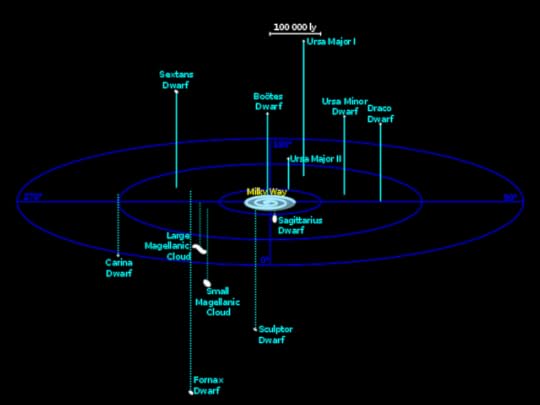
Image credit: Wikipedia, Richard Powell, Creative Commons Attribution-Share Alike 2.5 Generic
“Satellite galaxies that orbit from 1,000 ly (310 pc) of the edge of the disc of the Milky Way Galaxy to the edge of the dark matter halo of the Milky Way at 980×103 ly (300 kpc) from the center of the galaxy, are generally depleted in hydrogen gas compared to those that orbit more distantly. The reason is the dense hot gas halo of the Milky Way, which strips cold gas from the satellites. Satellites beyond that region still retain copious quantities of gas.” – Wikipedia article
In a recent paper “The tangential velocity excess of the Milky Way satellites“, Marius Cautun and Carlos Frenk find that a sample of satellites (drawn from those known for more than a few years) deviates from the predictions of the canonical Λ – Cold Dark Matter (ΛCDM) cosmology. (Λ refers to the cosmological constant, or dark energy).
“We estimate the systemic orbital kinematics of the Milky Way classical satellites and compare them with predictions from the Λ cold dark matter (ΛCDM) model derived from a semi-analytical galaxy formation model applied to high resolution cosmological N-body simulations. We find that the Galactic satellite system is atypical of ΛCDM systems. The subset of 10 Galactic satellites with proper motion measurements has a velocity anisotropy, β = −2.2 ± 0.4, that lies in the 2.9% tail of the ΛCDM distribution. Individually, the Milky Way satellites have radial velocities that are lower than expected for their proper motions, with 9 out of the 10 having at most 20% of their orbital kinetic energy invested in radial motion. Such extreme values are expected in only 1.5% of ΛCDM satellites systems. This tangential motion excess is unrelated to the existence of a Galactic ‘disc of satellites’. We present theoretical predictions for larger satellite samples that may become available as more proper motion measurements are obtained.”
Radial velocities are easy, we get those from redshifts. Tangential velocities are much tougher, but can be obtained from relatively nearby objects by measuring their proper motions. That is, how much do their apparent positions change on the sky after many years have passed. It’s all the more tough when your object is not a point object, but a fuzzy galaxy!
For a ‘random’ distribution of velocities in accordance with ΛCDM cosmology, one would expect the two components of tangential velocity to be each roughly equal on average to the radial component, and thus 2/3 of the kinetic energy would be tangential and 1/3 would be radial. But rather than 33% of the kinetic energy being in radial motion, they find that the Galactic satellites have only about 1/2 that amount in radial, and over 80% of their kinetic energy in tangential motion.
Formally, they find a negative velocity anistropy, β, which as it is defined in practice, should be around zero for a ΛCDM distribution. They find that β differs from zero by 5 standard deviations.
One possible explanation is that the dwarf galaxies are mainly at their perigee or apogee points of their orbits. But why should this be the case? Another explanation: “alternatively indicate that the Galactic satellites have orbits that are, on average, closer to circular than is typical in ΛCDM. This would mean that MW halo mass estimates based on satellite orbits (e.g. Barber et al. 2014) are biased low.” Perhaps the Milky Way halo mass estimate is too low. Or, they also posit, without elaborating, do the excess tangential motions “indicate new physics in the dark sector”?
So one speculation is that the tangential motions are reflective of emergent gravity class of theories, for which dark matter is not required, but for which the gravitational force changes (strengthens) at low accelerations, of order  , where H is the Hubble parameter, and the value works out to be around 2 centimeters per second per year. And it does this in a way that ‘spoofs’ the existence and gravitational affect of dark matter. This is also what is argued for in Modified Newtonian Dynamics, which is an empirical observation about galaxy light curves.
, where H is the Hubble parameter, and the value works out to be around 2 centimeters per second per year. And it does this in a way that ‘spoofs’ the existence and gravitational affect of dark matter. This is also what is argued for in Modified Newtonian Dynamics, which is an empirical observation about galaxy light curves.
In the next article of this series we will look at Erik Verlinde’s emergent gravity proposal, which he has just enhanced, and will attempt to explain it as best we can. If you want to prepare yourself for this challenging adventure, first read his 2011 paper, “On the Origin of Gravity and the Laws of Newton”.


October 21, 2016
Two Trillion Galaxies
Two trillion! That’s 2,000,000,000,000 galaxies. A trillion is a million times a million.
For a long time astronomers have said that our observable universe has about 100 billion galaxies. Two trillion is 2,000 billion, or 20 times larger.
It’s still smaller than the U.S. national debt at about $19 trillion, but those are just dollars, not galaxies. There are only 7 billion people on Earth, this number is 300 times larger.
Why so many?
Galaxies are not static. They evolve.
So what’s the twist, why were astronomers so wrong for so long? Well, it’s because now we can see galaxies much further away than before, thanks to the Hubble Space Telescope and other advanced telescopes. In fact we are now detecting many galaxies that were formed in the first billion years of the universe’s history.
And the universe is about 13.8 billion years old.
A team of astronomers from the University of Nottingham, the Leiden Observatory, and the University of Edinburgh, have built extremely detailed 3D maps of distant galaxies in order to estimate the density of these. They have used data from the Hubble Space Telescope and various ground-based telescopes.
When we look at distant galaxies we are also looking back into the past, since light travels at a finite speed. The researchers, lead by Prof. Christopher Consilice at the University of Nottingham, found the density of galaxies when the universe was a few billion years old to be about 10 times higher than at present (after correcting for the expansion of the universe). He noted that “we are missing the vast majority of galaxies because they are very faint and far away”.
These earlier galaxies were smaller, less massive, much less so. Large galaxies today like the Milky Way and the Andromeda galaxy have masses of around a trillion times the Sun. These galaxies were much more like the two dozen satellite galaxies found around the Milky Way, such as the Magellanic Clouds.

The Large Magellanic Cloud has a mass of about 1% of our Milky Way Galaxy. Image credit: NASA (C141 flight)
The main conclusion of the study? We know that galaxies undergo mergers. Apparently there have been many more mergers than previously assumed. Large galaxies such as our Milky Way have been formed by multiple successive mergers.

NGC 3921 is actually two galaxies in the process of merging. Note the strange and twisted orientation of the spiral arms, and the appearance of two disk like structures.Image credit: ESA/Hubble & NASA
So while there were originally trillions of galaxies in the early universe, in today’s universe the number has been reduced by mergers to order hundreds of billions.
Mergers will continue, in fact the Andromeda Galaxy is headed our way, and it’s twice as big as we are!
Reference
https://www.ras.org.uk/news-and-press/2910-a-universe-of-two-trillion-galaxies – Royal Astronomical Society press release


August 27, 2016
Pisces A and B: Dwarf Galaxies with Young Stars
 Pisces A and Pisces B as seen by Hubble Telescope; Image credit: NASA / ESA / E. Tollerud (STScI)
Pisces A and Pisces B as seen by Hubble Telescope; Image credit: NASA / ESA / E. Tollerud (STScI)The galaxies Pisces A and B are dwarf (very small) galaxies outside of our Local Group, but relatively nearby. Note their blue colors, indicating recent young star formation. The Local Group includes Andromeda, the Milky Way and another 50 or so smaller galaxies.
These two dwarfs are in a region of low density at the edge of the Local Void, an area with few galaxies. It appears they have recently moved out of the Local Void into a higher-density region. Their evolution and star formation may have sped up as this occurred.
Pisces A is nearer, around 18 million light-years away, and B is at 29 million light-years distance. Their masses are approximately 10 million and 30 million solar masses, respectively. By comparison, our Milky Way’s mass is 30 to 100 times larger.


August 25, 2016
The Antenna galaxies
This is a pair of colliding galaxies, presenting an absolutely stunning image. Each of the two spiral galaxies is not so different from our Milky Way. They have spent hundreds of millions of years in a violent cosmic dance. Stars are being ripped from the respective galaxies and flung out into an arc between the two.
Gas clouds are in reddish colors, and the star-forming regions are seen in blue. The Antennae are in starburst mode, which is a phase of very rapid star formation. There are also many prominent dust lanes (dark areas).
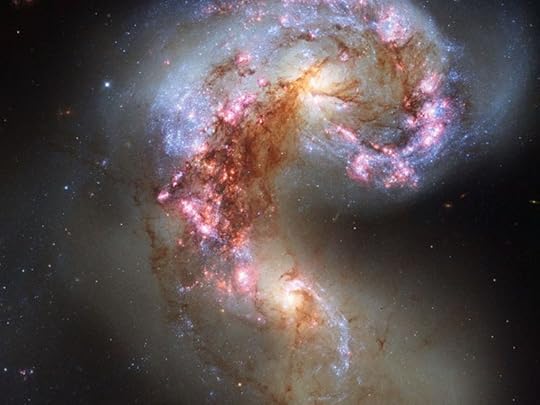
This is a composite image based on both visible and near-infrared data from the Hubble Space Telescope.


August 21, 2016
M31 – Andromeda Galaxy
“Our beautiful neighbor, M31, or the Andromeda Galaxy, is the best known galaxy apart from our Milky Way. M31 is a spiral galaxy, similar to, but larger than, our own galaxy. It has about two or three times the number of stars as the Milky Way.
M31 is visible to the naked eye on Moonless nights. Its existence has been known for over 1,000 years, but its nature as a galaxy separate from our own was not confirmed until around 1920, with the “Great Debate” between Harlow Shapley and Heber Curtis. Curtis was an advocate of many nebulae being external galaxies in their own right, and was proven correct.

Image credit: Andromeda Galaxy (with h-alpha)” by Adam Evans – M31, the Andromeda Galaxy (now with h-alpha), Uploaded by NotFromUtrecht. Licensed under CC BY 2.0 via Wikimedia Commons
Our galaxy and the Andromeda Galaxy are gravitationally bound together in our Local Group, along with about 50 other galaxies, which are almost all small dwarf galaxies.
The distance to the Andromeda Galaxy is around 2.5 million light-years (thus we are seeing it as it was 2.5 million years ago). The mass is estimated at over a trillion solar masses, and it has a star count of approximately a trillion stars. It is moving toward us at 300 kilometers per second (1/1000 of the speed of light). It[…]”
Excerpt From: “72 Beautiful Galaxies” iBooks.


M63 – Sunflower Galaxy
“M63 is an Sb spiral in the direction of Canes Venatici. It was discovered in 1779 by Pierre Mechain, a friend of Charles Messier, who composed the Messier catalog. The nickname of this galaxy, the “Sunflower” galaxy is reasonably obvious, since it has a shape and coloration similar to a sunflower and exhibits beautiful yellow colors as well as blue. The latter are regions with recent ongoing star formation. Its spiral arms were first noticed in the mid-19th century.
The Sunflower galaxy is 37 million light-years distant, and is part of a group of galaxies together with M51.”
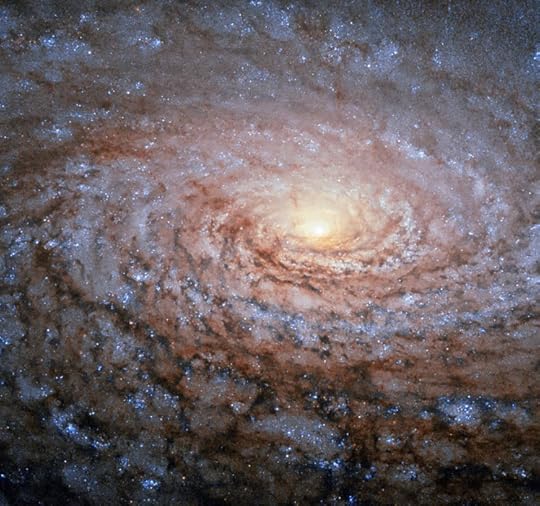
Excerpt From: “72 Beautiful Galaxies.FINAL.Aug16, 2016.” iBooks. Image credit: NASA


M64 – Blackeye Galaxy
A collision of two galaxies caused the unusual appearance of the Blackeye Galaxy. The black area in this galaxy is due to massive amounts of dust on this side of the center. While the stars are all revolving around the galaxy’s center in the same sense, a significant amount of gas in the outer regions is moving in the opposite sense. From this, astronomers deduce that a smaller galaxy collided with M64 in the past, perhaps a billion years ago or more.
There is a boundary where the outer region gas, moving in the opposite sense of the stars, meets gas in the inner region, which moves with the stars. In the boundary region the gas clouds moving in opposite directions are colliding, leading to higher density regions, and new star formation is thus enhanced.
The pink regions are hydrogen gas glowing in the red part of the spectrum after absorbing ultraviolet light from new hot stars.
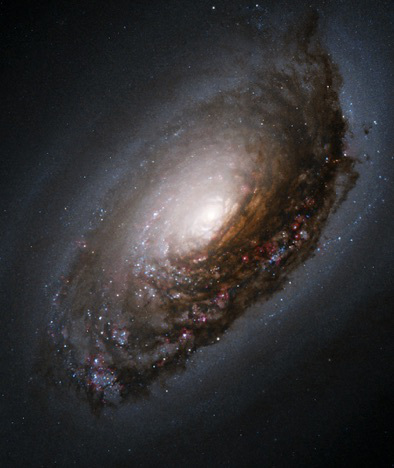
Image credit: NASA and The Hubble Heritage Team (AURA/STScI)


July 18, 2016
WIMPs or MACHOs or Primordial Black Holes
A decade or more ago, the debate about dark matter was, is it due to WIMPs (weakly interacting massive particles) or MACHOs (massive compact halo objects)? WIMPs would be new exotic particles, while MACHOs are objects formed from ordinary matter but very hard to detect due to their limited electromagnetic radiation emission.

Schwarzenegger (MACHO), not Schwarzschild (Black Holes)
Image credit: Georges Biard, CC BY-SA 3.0
Candidates in the MACHO category such as white dwarf or brown dwarf stars have been ruled out by observational constraints. Black holes formed in the very early universe, dubbed primordial black holes, were thought by many to have been ruled out as well, at least across many mass ranges, such as between the mass of the Moon and the mass of the Sun.
The focus during recent years, and most of the experimental searches, has shifted to WIMPs or other exotic particles (axions or sterile neutrinos primarily). But the WIMPs, which were motivated by supersymmetric extensions to the Standard Model of particle physics, have remained elusive. Most experiments have only placed stricter and stricter limits on their possible abundance and interaction cross-sections. The Large Hadron Collider has not yet found any evidence for supersymmetric particles.
Have primordial black holes (PBHs) as the explanation for dark matter been given short shrift? The recent detections by the LIGO instruments of two gravitational wave events, well explained by black hole mergers, have sparked new interest. A previous blog entry addressed this possibility:
https://darkmatterdarkenergy.com/2016/06/17/primordial-black-holes-as-dark-matter/.
The black holes observed in these events have masses in a range from about 8 to about 36 solar masses, and they could well be primordial.
There are a number of mechanisms to create PBHs in the early universe, prior to the very first second and the beginning of Big Bang nucleosynthesis. At any era, if there is a total mass M confined within a radius R, such that
2*GM/R > c^2 ,
then a black hole will form. The above equation defines the Schwarzschild limit (G is the gravitational constant and c the speed of light). A PBH doesn’t even have to be formed from matter whether ordinary or exotic; if the energy and radiation density is high enough in a region, it can also result in collapse to a black hole.
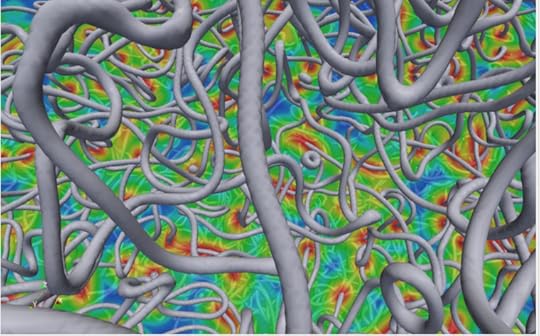
Cosmic Strings
Image credit: David Daverio, Université de Genève, CSCS supercomputer simulation data
The mechanisms for PBH creation include:
Cosmic string loops – If string theory is correct the very early universe had very long strings and many short loops of strings. These topological defects intersect and form black holes due to the very high density at their intersection points. The black holes could have a broad range of masses.
Bubble collisions from symmetry breaking – As the very early universe expanded and cooled, the strong force, weak force and electromagnetic force separated out. Bubbles would nucleate at the time of symmetry breaking as the phase of the universe changed, just as bubbles form in water as it boils to the surface. Collisions of bubbles could lead to high density regions and black hole formation. Symmetry breaking at the GUT scale (for the strong force separation) would yield BHs of mass around 100 kilograms. Symmetry breaking of the weak force from the electromagnetic force would yield BHs with a mass of around our Moon’s mass ~ 10^25 kilograms.
Density perturbations – These would be a natural result of the mechanisms in #1 and #2, in any case. When observing the cosmic microwave background radiation, which dates from a time when the universe was only 380,000 years old, we see density perturbations at various scales, with amplitudes of only a few parts in a million. Nevertheless these serve as the seeds for the formation of the first galaxies when the universe was only a few hundred million years old. Some perturbations could be large enough on smaller distance scales to form PBHs ranging from above a solar mass to as high as 100,000 solar masses.
For a PBH to be an effective dark matter contributor, it must have a lifetime longer than the age of the universe. BHs radiate due to Hawking radiation, and thus have finite lifetimes. For stellar mass BHs, the lifetimes are incredibly long, but for smaller BHs the lifetimes are much shorter since the lifetime is proportional to the cube of the BH mass. Thus a minimum mass for PBHs surviving to the present epoch is around a trillion kilograms (a billion tons).
Carr et al. (paper referenced below) summarized the constraints on what fraction of the matter content of the universe could be in the form of black holes. Traditional black holes, of several solar masses, created by stellar collapse and detectable due to their accretion disks, do not provide enough matter density. Neither do supermassive black holes of over a million solar masses found at the centers of most galaxies. PBHs may be important in seeding the formation of the supermassive black holes, however.
Limits on the PBH abundance in our galaxy and its halo (which is primarily composed of dark matter) are obtained from:
Cosmic microwave background measurements
Microlensing measurements (gravitational lensing)
Gamma-ray background limits
Neutral hydrogen clouds in the early universe
Wide binaries (disruption limits)
Microlensing surveys such as MACHO and EROS have searched for objects in our galactic halo that act as gravitational lenses for light originating from background stars in the Magellanic Clouds or the Andromeda galaxy. The galactic halo is composed primarily of dark matter.
A couple of dozen of objects with less than a solar mass have been detected. Based on these surveys the fraction of dark matter which can be PBHs with less than a solar mass is 10% at most. The constraints from 1 solar mass up to 30 solar masses are weaker, and a PBH explanation for most of the galactic halo mass remains possible.
Similar studies conducted toward distant quasars and compact radio sources address the constraint in the supermassive black hole domain, apparently ruling out an explanation due to PBHs with from 1 million to 100 million solar masses.
Lyman-alpha clouds are neutral hydrogen clouds (Lyman-alpha is an important ultraviolet absorption line for hydrogen) that are found in the early universe at redshifts above 4. Simulations of the effect of PBH number density fluctuations on the distribution of Lyman-alpha clouds appear to limit the PBH contribution to dark matter for a characteristic PBH mass above 10,000 solar masses.
Distortions in the cosmic microwave background are expected if PBHs above 10 solar masses contributed substantially to the dark matter component. However these limits assume that PBH masses do not change. Merging and accretion events after the recombination era, when the cosmic microwave background was emitted, can allow a spectrum of PBH masses that were initially less than a solar mass before recombination evolve to one dominated by PBHs of tens, hundreds and thousands of solar masses today. This could be a way around some of the limits that appear to be placed by the cosmic microwave background temperature fluctuations.
Thus it appears could be a window in the region 30 to several thousand solar masses for PBHs as an explanation of cold dark matter.
As the Advanced LIGO gravitational wave detectors come on line, we expect many more black hole merger discoveries that will help to elucidate the nature of primordial black holes and the possibility that they contribute substantially to the dark matter component of our Milky Way galaxy and the universe.
References
B. Carr, K. Kohri, Y. Sendouda, J. Yokoyama, 2010 arxiv.org/pdf/0912.5297v2 “New cosmological constraints on primordial black holes”
S. Cleese and J. Garcia-Bellido, 2015 arxiv.org/pdf/1501.07565v1.pdf “Massive Primordial Black Holes from Hybrid Inflation as Dark Matter and the Seeds of Galaxies”
P. Frampton, 2015 arxiv.org/pdf/1511.08801.pdf “The Primordial Black Hole Mass Range”
P. Frampton, 2016 arxiv.org/pdf/1510.00400v7.pdf “Searching for Dark Matter Constituents with Many Solar Masses”
Green, A., 2011 https://www.mpifr-bonn.mpg.de/1360865/3rd_WG_Green.pdf “Primordial Black Hole Formation”
P. Pani, and A. Loeb, 2014 http://xxx.lanl.gov/pdf/1401.3025v1.pdf “Exclusion of the remaining mass window for primordial black holes as the dominant constituent of dark matter”
S. Perrenod, 2016 https://darkmatterdarkenergy.com/2016/06/17/primordial-black-holes-as-dark-matter/
NEW BOOK just released:
S. Perrenod, 2016, 72 Beautiful Galaxies (especially designed for iPad, iOS; ages 12 and up)
